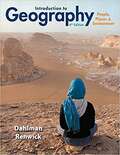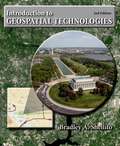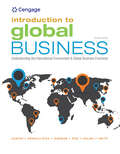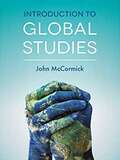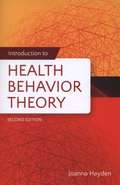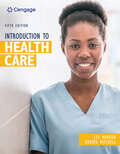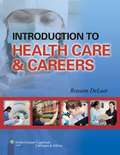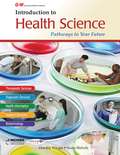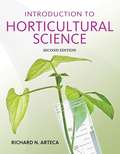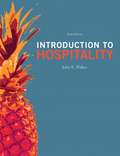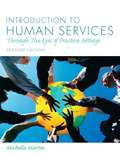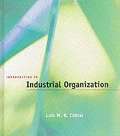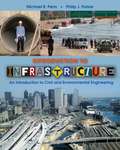- Table View
- List View
Introduction to Functional Magnetic Resonance Imaging
by Richard B. BuxtonFunctional Magnetic Resonance Imaging (fMRI) has become a standard tool for mapping the working brain's activation patterns, both in health and in disease. It is an interdisciplinary field and crosses the borders of neuroscience, psychology, psychiatry, radiology, mathematics, physics and engineering. Developments in techniques, procedures and our understanding of this field are expanding rapidly. In this second edition of Introduction to Functional Magnetic Resonance Imaging, Richard Buxton - a leading authority on fMRI - provides an invaluable guide to how fMRI works, from introducing the basic ideas and principles to the underlying physics and physiology. He covers the relationship between fMRI and other imaging techniques and includes a guide to the statistical analysis of fMRI data. This book will be useful both to the experienced radiographer, and the clinician or researcher with no previous knowledge of the technology.
Introduction to Geography: People, Places and Environment
by Carl Dahlman William RenwickIntroduction to Geography: People, Places, & Environment, Sixth Edition introduces the major tools, techniques, and methodological approaches of the discipline through new applied visual features that engage students and reinforce real-world connections. <P><P> The authors emphasize the integration of various aspects of geographic processes and systems by discussing what happens in one set of geographic processes and how that affects others. For example, what happens in economic systems affects environmental conditions; what happens to climate affects political dynamics. The Sixth Edition has been tightly integrated with MasteringGeography™, Pearson’s online homework, tutorial, and assessment product designed to improve results by helping students quickly master concepts.
Introduction to Geospatial Technologies (Second Edition)
by Bradley A. ShellitoCombining both theoretical coverage and hands-on lab work, and accessible to majors and non-majors alike, Bradley Shellito's Introduction to Geospatial Technologies has become a new favorite for the digital Earth course. The new edition reflects the latest developments in the field, including how scientists are using GIS data with cloud technology. With lab activities that utilize both widely available freeware and ArcGIS, instructors can tailor the course to their students.
Introduction to Global Business: Understanding the International Environment and Global Business Functions
by Leonard Bierman James W. Kolari L. Murphy Smith Antonio Arreola-Risa Julian E. Gaspar Richard T. HiseThe global business environment is rapidly changing due to shifts in geopolitical alliances, active support of international institutions in promoting market-oriented economic reforms, and advances in the development and use of information technology. INTRODUCTION TO GLOBAL BUSINESS, 2e addresses these challenges by providing a comprehensive analysis of the global business environment and lays the foundation for the functional tools used to better prepare students for a global business landscape. <P><P>The text flows smoothly and clearly from concept to application, asking your students to apply their learning to real-world personal and professional applications. The specialized author team introduces globalization through unparalleled scholarship and a world-view presentation of the fundamental pillars of the global business environment -- culture, ethics, economics, and information technology. Ensure that your students understand the procedures and concepts they need to know with MindTap for INTRODUCTION TO GLOBAL BUSINESS. MindTapTM, an online course management and learning system, combines the best of current technology to save time in planning and managing your course and assignments.
Introduction to Global Studies
by John McCormickThis textbook provides a multidisciplinary introduction to Global and International Studies. Offering unrivalled breadth and depth, it covers all the key dimensions of the topic, including broad introductions to international politics and economics, and focused surveys of topics from human rights and migration to conflict and the environment. <p><p>John McCormick’s lucid writing style renders complex information understandable to all students. Full-colour photographs, maps, tables and figures bring the subject to life and innovative pedagogical features emphasize the importance of understanding perspectives and experiences different from one’s own worldview. <p><p>Assuming no prior knowledge of the subject, this textbook is ideal for undergraduate students worldwide who are taking introductory modules in Global and International Studies. The text can also be used by undergraduate students taking courses on Globalization.
Introduction to Governmental and Not-for-profit Accounting (7th Edition)
by Terry K. Patton Martin Ives Larry A. Johnson Joseph R. Razek Gordon A. Hosch Suesan R. PattonCovering the essentials of fund accounting, this flexible book introduces the reader to the basic accounting principles at work in both governmental and not-for-profit organizations.
Introduction to Graphic Design: A Guide to Thinking, Process and Style (Required Reading Range #74)
by Aaris SherinFor a great foundation as a graphic design student, look no further than Aaris Sherin's Introduction to Graphic Design. Sherin will introduce you to the formal structure of graphic design, so you can understand and utilise the main techniques of your chosen profession, and learn how they apply to print and screen-based projects. Whether you need to conceptualise a new poster, develop an exciting advertisement, structure an app or create eye-catching signage, chapters can be read in any order you choose, depending on which area you wish to concentrate. <p><p> Whatever your approach, you'll be encouraged to use critical thinking, visual exploration and understand the special relationship graphic designers have to creative problem solving. There are also chapters devoted to imagery, color, and typography, using a thematic approach to creative problem-solving. With over 500 images showing examples from international designers, helpful diagrams, highlighted key terms and concepts, Design in Action case studies, exercises and chapter-by-chapter Dos and Don'ts, Introduction to Graphic Design will give newcomers to graphic design the confidence to give visual form to concepts and ideas.
Introduction to Health Behavior Theory (Second Edition)
by Joanna Aboyoun HaydenIntroduction to Health Behavior Theory, Second Edition is designed to provide students with an easy to understand, interesting, and engaging introduction to the theoretical basis of health education. Written with the undergraduate in mind, the text uses comprehensive and accessible explanations to help students understand what theory is, how theories are developed, and what factors influence health behavior theory. Covering the more frequently used health behavior theories, the author breaks each theory into concepts and constructs to enhance comprehension and encourage students to discover how these theories can be put into practice. New to the Second Edition:* Data, information, and illustrations updated throughout, including the new "My Plate"* A new Theory in Action article and new classroom activities in each theory chapter* New and revised chapters on Social Ecological Models and Social Capital Theory
Introduction to Health Care
by Lee Haroun Dakota MitchellReflecting current practices and the latest research, Haroun/Mitchell's INTRODUCTION TO HEALTH CARE, Fifth Edition, provides a student-friendly introduction to the foundational skills necessary for a range of health care professions. This trusted text offers a comprehensive yet highly accessible survey of both soft skills and basic clinical skills for those entering health care training programs or considering a career in health care. It emphasizes core competencies required by all health care professions, including communication, infection control and professionalism. With a strong focus on developing critical thinking skills, the text uses a five-step problem-solving model to teach students to "think like" health care professionals. Completely up to date, the Fifth Edition includes expanded coverage of the opioid crisis, precision/personalized medicine, suicide prevention, health disparities and much more. Also available: MindTap digital learning solution.
Introduction to Health Care Management
by null Sharon B. Buchbinder null Nancy H. Shanks null Bobbie J KiteIntroduction to Health Care Management, Fourth Edition is a concise, reader-friendly, introductory healthcare management text that covers a wide variety of healthcare settings, from hospitals to nursing homes and clinics. Filled with examples to engage the reader’s imagination, the important issues in healthcare management, such as ethics, cost management, strategic planning and marketing, information technology, and human resources, are all thoroughly covered. Guidelines and rubrics along with numerous case studies make this text both student-friendly and teacher-friendly. It is the perfect resource for students of healthcare management, nursing, allied health, business administration, pharmacy, occupational therapy, public administration, and public health.
Introduction to Health Care and Careers
by Roxann Delaet<p><i>Introduction to Health Care and Careers</i> provides students beginning their health care education with the fundamentals they need to develop their personal and professional skills, understand their chosen profession, and succeed in the world of health care. It meets the growing market demand for a book that gives the best of both worlds—skill development and career choice information. The text begins with today’s health care system, health care economics, and law and ethics, providing important context for the personal, professional, and workplace skills that follow. From there, students move on to an overview of careers in health care and detailed profiles of the most in-demand professions. The book closes with brief chapters on anatomy and physiology to prepare students for the rest of their health care education. <p>With its student friendly approach,<i>Introduction to Health Care and Careers</i> is the essential resource for introductory health care courses, striking the perfect balance between skill development and up-to-date career choice information–everything health care students need to succeed.</p>
Introduction to Health Science: Pathways to Your Future
by Dorothy J. Winger Susan BlahnikIntroduction to Health Science: Pathways to Your Future is a pathway-focused textbook program that helps you explore and prepare for healthcare careers. Organized into untis based on the five health science pathways, the text covers all the skills and knowledge areas included in the National Health Science Standards. Assessment activities at the end of each chapter offer multiple opportunities for students to simulate heathcare careers, practice skills, and to think deeply about the information they've learned.
Introduction to Horticultural Science (Second Edition)
by Richard N. ArtecaDesigned to provide readers with a full appreciation of the wonderful world of horticultural science, the Second Edition of INTRODUCTION TO HORTICULTURAL SCIENCE covers everything the reader needs to know in a comprehensive format that is easy to understand. Coverage includes critical topics such as fundamental concepts, cutting edge research, careers in horticulture, the relationship between horticulture and the environment, classification of plants, and plant anatomy. Readers are also introduced to key concepts such as plant propagation, media, nutrients and fertilizers, plants and the environment, plant growth regulators, post harvest physiology and pest management, greenhouse structures, nursery site selection, development and facilities, producing nursery crops, and floral design. Through enhanced visual aids and the inclusion of recent trends in the field, the second edition has been designed to peak reader interest and improve reader understanding.
Introduction to Horticulture (4th edition)
by Charles B. Schroeder Eddie Dean Seagle Gerard Krewer John M. Ruter Lorie M. Felton William Terry KellyThe Fourth Edition of Introduction to Horticulture represents a major step forward for horticulture books in agricultural education. The attractive, student-friendly book has been expanded and made much more appealing. Changes from the prior editions have made this book increasingly useful in the hands of students.
Introduction to Hospitality (6th edition)
by John R. WalkerThe Sixth Edition of Introduction to Hospitality focuses on hospitality operations while offering a broad, comprehensive foundation of current knowledge about the world's largest industry. The text is organized into five sections: the hospitality industry and tourism; lodging; restaurants, managed services, and beverages; recreation, theme parks, clubs, and gaming entertainment; and assemblies and event management.
Introduction to Hospitality (Seventh Edition)
by John R. WalkerPrepares students to succeed in any area of the hospitality industry. Introduction to Hospitality, 7/e, focuses on hospitality operations while offering a broad, comprehensive view of the world’s largest industry. The text is organized into four sections: hospitality and lodging; beverages, restaurants, and managed services; tourism, recreation, attractions, clubs, and gaming; and assemblies, events, attractions, leadership, and management. Each section includes real-world profiles, first-hand accounts, and engaging case studies to help readers connect with the material and foster an appreciation of the industry’s unique enthusiasm and passion. New photos, page layouts, and hands-on examples help students understand the how-to aspects of today’s hospitality industry. Updated to reflect today’s trends and realities, the Seventh Edition contains new coverage of spas, updated and new corporate profiles, salary information, hospitality-related technologies, and more!
Introduction to Human Geography
by David Dorrell Joseph P. HendersonGeography is a diverse discipline that has some sort of connection to most every other academic discipline. This connection is the spatial perspective, which essentially means if a phenomenon can be mapped, it has some kind of relationship to geography. Studying the entire world is a fascinating subject, and geographical knowledge is fundamental to a competent understanding of our world. You will learn what geography is as well as some of the fundamental concepts that underpin the discipline. These fundamental terms and concepts will be interwoven throughout the text, so a sound understanding of these topics is critical as you delve deeper into the chapters that follow. By the end of the first chapter itself, you will begin to think like a geographer.
Introduction to Human Services: Through the Eyes of Practice Settings (2nd edition)
by Michelle MartinThis highly readable human services text offers a generalist view of the breadth and scope of human services. This text uses various practice settings as a lens for examining the role and functions of the human service professional. Because the human services profession grew out of a concern about social problems that prevented people from getting their needs met, it is important to examine the generalist role of human service professionals. In addition, exploring the nature of working with individuals, families, or groups is more meaningful when explored within the context of a particular practice setting.
Introduction to Industrial Organization
by Luís M. B. CabralOver the past twenty years, the study of industrial organization--the analysis of imperfectly competitive markets--has grown from a niche area of microeconomics to a key component of economics and of related disciplines such as finance, strategy, and marketing. This book provides an issue-driven introduction to industrial organization. It includes a vast array of examples, from both within and outside the United States. While formal in its approach, the book is written in a way that requires only basic mathematical training. Supplemental materials posted on the Web make more extensive use of algebra and calculus.
Introduction to Information Systems (14th edition)
by James A. O'Brien George M. MarakasO'Brien's Introduction to Information Systems 14e continues to reflect the movement toward enterprise-wide business applications. George Marakas from the University of Kansas joins as a co-author on this new edition. New real world case studies correspond with this curriculum shift. The texts focus is on teaching the general business manager how to use and manage the most current IT technologies such as the Internet, Intranets, and Extranets for enterprise collaboration, and how IT contributes to competitive advantage, re-engineering business processes, problem solving, and decision-making.
Introduction to Information Systems: Seventh Edition
by R. Kelly Rainer Casey G. CegielskiThe goal of Introduction to Information Systems is to teach undergraduate business majors how to use information technology to master their current or future jobs. Students develop a working understanding of information systems and information technology and learn how to apply concepts to successfully facilitate business processes. This product demonstrates that IT is a key component of any business, whether a student is majoring in Accounting, Finance, Marketing, Human Resources, or Production/Operations Management.
Introduction to Infrastructure: An Introduction to Civil and Environmental Engineering
by Philip J. Parker Michael R. PennIntroduction to Infrastructure: An Introduction to Civil andEnvironmental Engineering breaks new ground in preparingcivil and environmental engineers to meet the challenges of the21st century.



